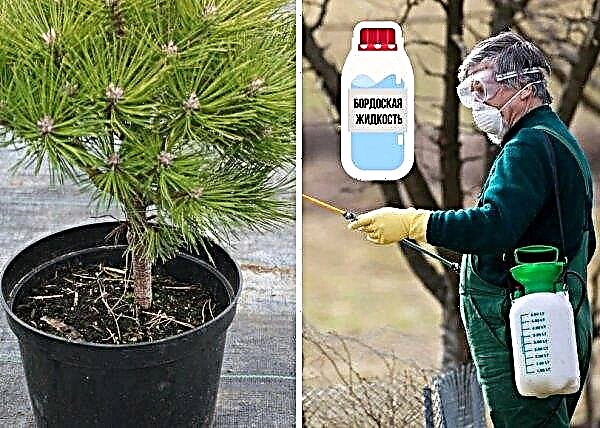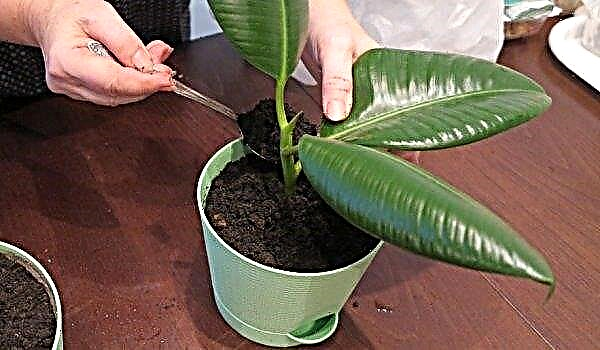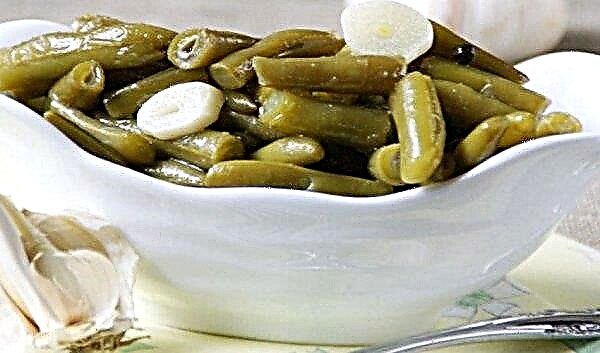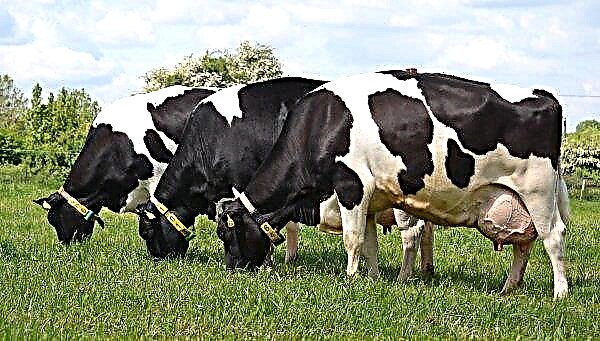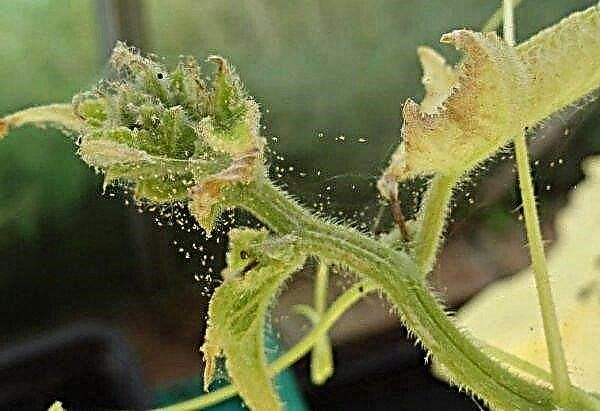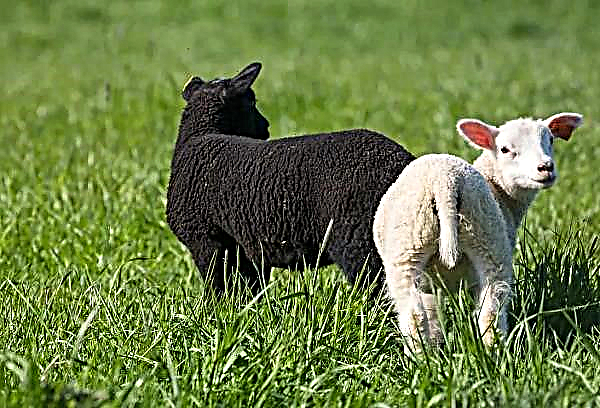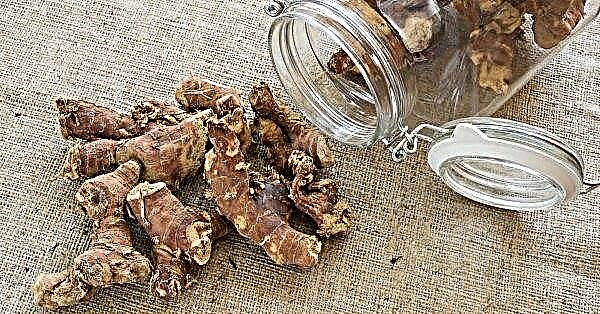White cabbage is the most popular variety of this vegetable, therefore it is not surprising that it can be found in almost every summer cottage. Unfortunately, like other plants, it is susceptible to negative influences from the outside, and one of the most common problems is cracking of the heads "on the vine." Why this happens and how to prevent such troubles - you will learn more about this later.
Cabbage Cracks Why This Happens
There are many reasons for cracking cabbage heads, but most often this is due to the following phenomena:
- Watering violationsthat lead to excessive moisture accumulation in the heads. Perhaps you did not water the crop for a long time, and then poured into the soil a large amount of water bursting inside the vegetable. Prolonged rainy weather, especially accompanied by temperature spikes, can lead to the same result. Gathering moisture, all the leaves begin to grow intensively, but young and juicy lower leaves make it faster than the upper ones, because of which the forks simply break.
- Long head stay in the garden - Another reason that their surface is cracking. Overripe vegetables always burst, but often this happens with early varieties, the aboveground formation of which ends when the roots still continue to supply moisture upward.
- Sudden changes in temperature, which can also serve as a basis for violating the integrity of cabbage. This usually happens in late August or early September, when summer heat is increasingly replaced by autumn coolness. For example, if the temperature values did not rise above + 20 ° C for a long time and the head growth managed to slow down, even a short-term increase in the values to + 25 ° C can lead to a sharp resumption of growth of the lower leaves, which leads to cracking.
- Varietal characteristics of plants. Resin varieties react more sharply to temperature changes, so they crack much more often. This can be avoided with the help of timely harvesting, a signal to the beginning of which will be a change in the color of the upper leaves. Varieties Marathon, Albatross, Kolobok are considered one of the most resistant to cracking heads.
If, in addition to cracking the surface on the heads of cabbage, traces of wilting and graying of the ends of the leaves are noticeable, it is time to think about the possible development of ailments: vascular bacteriosis, keel of cabbage or fusarium wilting, the negative impact of which increases significantly in hot and dry periods.
Did you know? Sour cabbage soup was not always called first courses. In Tsarist Russia, this name meant special spicy drinks made from cabbage and a bit like kvass. In most cases, they used such a drink after taking a bath or with a hangover, as it perfectly tones up and added strength.
The right ways to protect cabbage
You can deal with cracking cabbage only with timely prevention, based on compliance with all requirements for the care of plants. First of all, this concerns the organization of irrigation and the selection of a scheme for feeding plantings, but monitoring the condition of the heads themselves is no less important.
Head Care
The main measures for caring for heads of cabbage provide for their sufficient feeding and moisturizing, but temperature control and timely shading of plantings from scorching sunlight will be equally important. This can be done using burlap, stretched over the bed, and regular watering with a sprinkling method that will help to moisten the whole plant evenly and prevent it from drying out.
Important! If you notice signs of putrefactive processes on the cabbage, you should immediately remove such a head from the garden bed, even if it has not yet burst. Even one plant can become a source of infection for the rest, so you should not risk the quality of the entire crop.
Do not forget about the timely removal of weeds. Growing up, they create a shadow, preventing the cabbage from drying out normally in the sun. In addition, with increased soil moisture, the activity of pathogens that contribute to the development of diseases increases. To prevent crops from possible decay will help preventive treatment with a solution of chemical preparations (for example, Fitosporin) and several simple actions. If the heads of cabbage are already fully formed, but you still don’t have the opportunity to harvest, just grab each head with your hands and slightly scroll left and right (about 50 °), then slightly lift it up. With moderate efforts, it is unlikely that you can completely pull the plant out of the ground, but the small roots supplying the plant with moisture will certainly become smaller.
If the heads of cabbage are already fully formed, but you still don’t have the opportunity to harvest, just grab each head with your hands and slightly scroll left and right (about 50 °), then slightly lift it up. With moderate efforts, it is unlikely that you can completely pull the plant out of the ground, but the small roots supplying the plant with moisture will certainly become smaller.
Watering
Properly organized watering is the main condition for moderate hydration of the crop. Of course, cabbage can be attributed to moisture-loving crops, but this is not a reason to water it more than once every 2-3 days in moderately hot weather and every other day during strong summer heat. If during the period between watering it rained heavily, the next application of the liquid should be postponed for another few days.
Did you know? A close relative of white cabbage is its red-headed version, which is great for home experiments: try putting a small amount of chopped vegetable in a bowl of water and add a little soda or vinegar. In the first case, the plant turns blue, and in the second it becomes raspberry.
Check if the plant needs additional moisture, you can use a small test. At a depth of 10 cm, take a little earth and squeeze the soil in your hand: a tightly crumpled lump that holds its shape when you open your fist indicates sufficient moisture, but if the earth crumbled into dust, you will have to water the plantings. Drop watering is preferable to basal irrigation, because it allows you to evenly distribute water over the entire surface of the head and dosed to supply moisture to the rhizome itself. In addition, an automatic drip system of humidification of beds is perfect for those summer residents who rarely come to their site and can not often perform manual watering.
Drop watering is preferable to basal irrigation, because it allows you to evenly distribute water over the entire surface of the head and dosed to supply moisture to the rhizome itself. In addition, an automatic drip system of humidification of beds is perfect for those summer residents who rarely come to their site and can not often perform manual watering.
Approximately 3 weeks before the intended harvest, the introduction of liquid is recommended to be stopped. Natural precipitation will be quite enough for optimal soil moisture, but if there are too many of them, you will have to take care of the system to remove excess moisture and break the heads a little, turning them 50-60 degrees in each direction.
Fertilizer method
Top dressing of early and late varieties of white cabbage should be an indispensable component of caring for it throughout the growing period. However, in this matter it is very important not to overdo it, because in addition to possible cracking of the heads, accumulation of nitrates inside the heads cannot be excluded.
However, in this matter it is very important not to overdo it, because in addition to possible cracking of the heads, accumulation of nitrates inside the heads cannot be excluded.
- First feeding dive seedlings are performed on 8–11 days after it is moved into separate pots. In this case, it is worth using liquid mineral fertilizers made from potassium chloride (3 g), ammonium nitrate (7.5 g) and superphosphate (12 g) diluted in 3 l of water as nutrient mixtures.
- Repeated fertilizer young plants are carried out approximately 2 weeks after the previous top dressing, and this time use 2-3 g of ammonium nitrate diluted in 1 liter of water.
- If you wish, you can carry out the third top dressing seedlings (3-4 days before planting the crop in open soil), using a solution of two liters of water, 4 g of potassium chloride, 6 g of nitrate and at least 15 g of superphosphate.
The application of any fertilizer should be combined with the next watering, so as not to burn the rhizome of young cabbage. After transplanting plants into open, not previously fertilized soil, the first top dressing can be performed 16 days after planting. The best time for this procedure is a cloudy day or late evening, preferably shortly after the next watering. As for specific nutrients, it is better to start with nitrogen-containing mixtures, presented in organic or in mineral form.
Important! You can not overfeed the cabbage with nitrogen-containing fertilizers. They are used only during intensive growth and filling of heads of cabbage so that the heads do not burst from overfeeding.
A good solution in this case is a solution of 20 liters of water and 1 liter of a liquid mullein solution, which after mixing is added to each bush (0.5 liter each). For the same amount of water, you can also take 40 g of superphosphate or 2 matchboxes of nitrate; True, in the latter case, cabbage will not need to be added, but sprayed. The second top dressing of the plant in the open field is carried out at the end of June or at the beginning of July, and if for the first time mineral nutrient compounds were used, now it is time for organics. A solution of chicken droppings or ash infusion (2 liters of water, 2 cups of ash) will be useful, which also helps to protect the plantings from pests by sticking to the leaves.
The second top dressing of the plant in the open field is carried out at the end of June or at the beginning of July, and if for the first time mineral nutrient compounds were used, now it is time for organics. A solution of chicken droppings or ash infusion (2 liters of water, 2 cups of ash) will be useful, which also helps to protect the plantings from pests by sticking to the leaves.
Cracked Cabbage Storage Tips
If, in spite of all your efforts, the cabbage heads are still cracked, no matter what, you have to cut them off immediately so that slugs and other pests do not settle in the resulting space. Such a crop is not suitable for laying for long-term storage, but it can still be used for starter or pickling vegetables. In addition, some housewives prefer to dry the cabbage in order to further prepare cabbage soup and second courses from it.
Properly prepared cabbage heads in this way can be stored in a dark room for about a year if all the sheets were well dried in an oven or dehydrator. You can fold the blank into dense paper bags, or sealed glass containers. Often, chopped bursted cabbage is sent for storage to the freezer, after washing and drying it at room temperature. There are no special requirements for the freezing process - the main thing is that the vegetables should be well dried at the time of placement in the refrigerator. As you can see, even cracked white cabbage can be used. However, it will not be possible to save it fresh, therefore, knowing about the possible causes of cracking, it is worthwhile to make every effort to prevent this. With properly organized care, even early varieties calmly lie in the garden for a long time.
There are no special requirements for the freezing process - the main thing is that the vegetables should be well dried at the time of placement in the refrigerator. As you can see, even cracked white cabbage can be used. However, it will not be possible to save it fresh, therefore, knowing about the possible causes of cracking, it is worthwhile to make every effort to prevent this. With properly organized care, even early varieties calmly lie in the garden for a long time.

